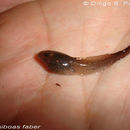en
names in breadcrumbs


The blacksmith tree frog (Boana faber), or smith frog, is a frog species in the family Hylidae. It is found in eastern to southern Brazil, north-eastern Argentina and south-eastern Paraguay.[1][2] Its natural habitats are tropical humid forests, including forest edges, at elevations of 150–800 m (490–2,620 ft) above sea level. Breeding takes place in temporary and permanent pools (including artificial pools) and slow-moving streams where the frogs make nests.[1]
This is an abundant species throughout its range. Clear cutting of forests remains a threat, whereas the species adapts to selectively logged and second growth forests. It is present in several protected areas. It is not considered threatened by the IUCN.[1]
{{cite journal}}: CS1 maint: multiple names: authors list (link)  Blacksmith tree frog, Atlantic Forest, Brazil
Blacksmith tree frog, Atlantic Forest, BrazilThe blacksmith tree frog (Boana faber), or smith frog, is a frog species in the family Hylidae. It is found in eastern to southern Brazil, north-eastern Argentina and south-eastern Paraguay. Its natural habitats are tropical humid forests, including forest edges, at elevations of 150–800 m (490–2,620 ft) above sea level. Breeding takes place in temporary and permanent pools (including artificial pools) and slow-moving streams where the frogs make nests.
This is an abundant species throughout its range. Clear cutting of forests remains a threat, whereas the species adapts to selectively logged and second growth forests. It is present in several protected areas. It is not considered threatened by the IUCN.